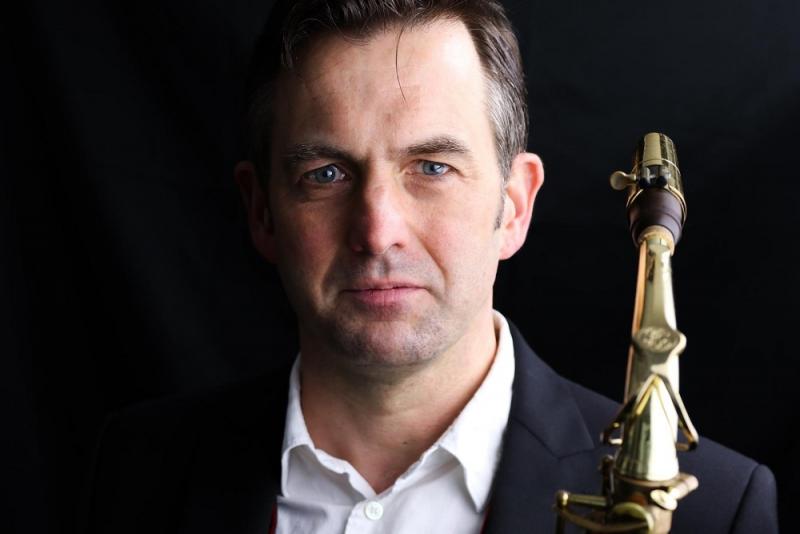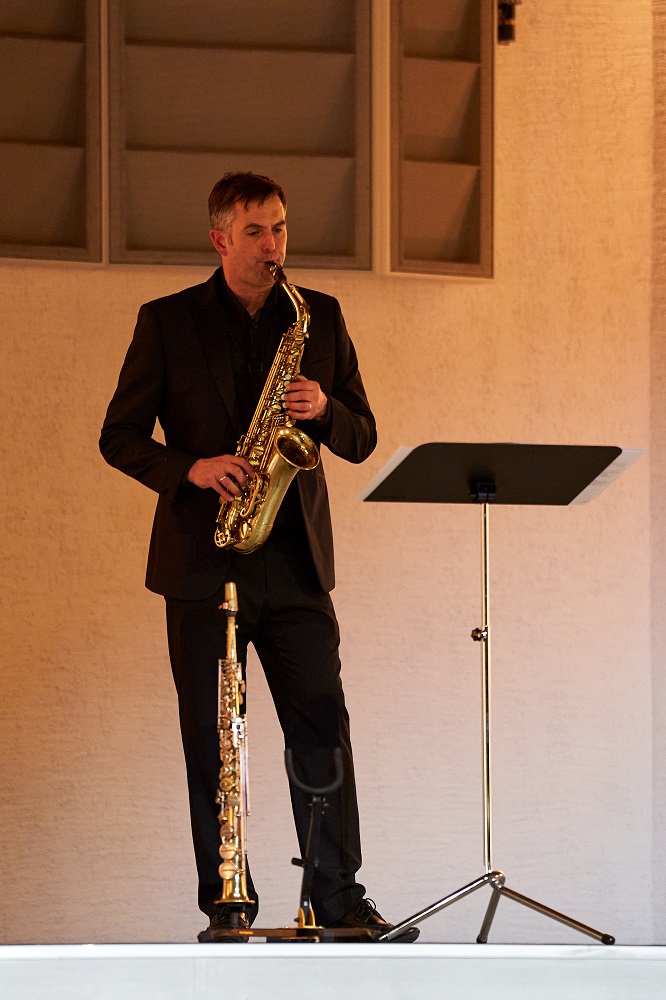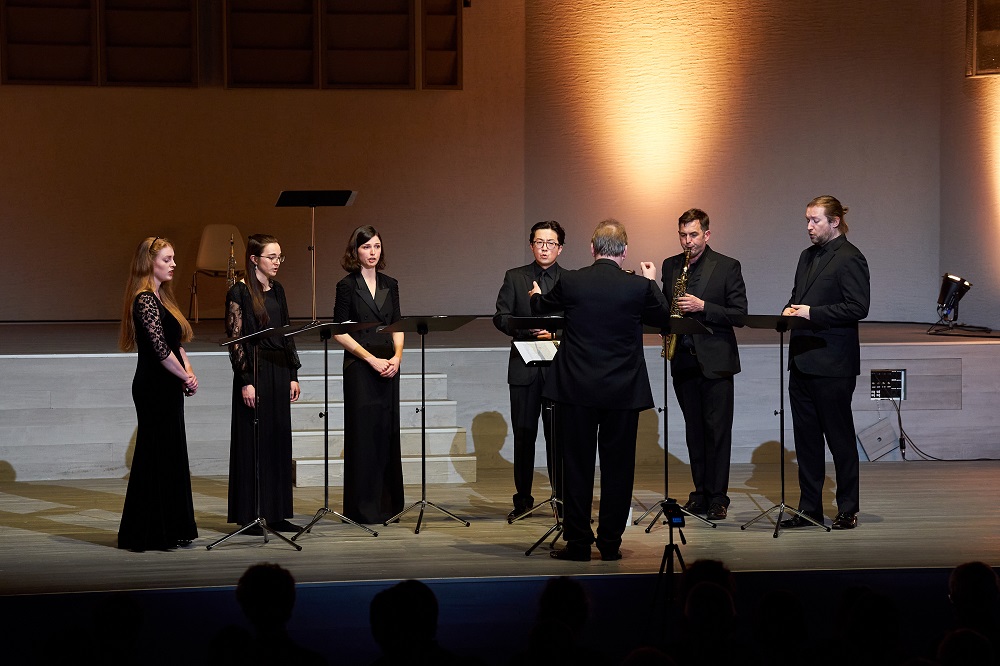'An invitation to stillness and reflection': saxophonist and composer Christian Forshaw on collaborating with top choir Tenebrae | reviews, news & interviews
'An invitation to stillness and reflection': saxophonist and composer Christian Forshaw on collaborating with top choir Tenebrae
'An invitation to stillness and reflection': saxophonist and composer Christian Forshaw on collaborating with top choir Tenebrae
On the vocal quality of his chosen instrument and an invitation to stillness

The idea of recording an album with Tenebrae has been bubbling away for a number of years. Nigel Short and I first worked together in 2007 when I asked him to direct the vocal consort for a UK tour I was doing with my own group. Since then we have worked together on a number of projects and regularly discussed the idea of a collaboration with Tenebrae.
The juxtaposition of saxophone and voices has been central to my work as a composer, arranger and performer for almost 30 years. The way sound can morph from one to the other in an almost imperceptible way has fascinated musicians from all genres for over a century. Johnny Hodges & Ella Fitzgerald, Stan Getz & Astrud Gilberto and John Dankworth & Cleo Laine have all brought their own unique approaches to this combination of forces.
My own concept of sound derived from my days as a chorister. That aesthetic has always been central to the way I approach the saxophone, aiming to phrase and resonate like a singer. I enjoy the way there is so much common ground between the two, but also how they are also able to depart from each other and explore their own uniqueness.
 Adolph Sax’s invention was born from a desire to create a hybrid between woodwind and brass; an instrument which could produce the same levels of sound as a brass instrument but with the warmth and intimacy of a woodwind instrument. Despite the obvious similarities in appearance to a brass instrument, the instrument very much behaves like a member of the woodwind family, particularly the oboe. The bore is conical but with a much wider flare than that of the oboe, meaning the instrument has an exceptionally wide dynamic range. But as well as dynamic range, the bore shape means it is possible to resonate to a very high degree using the same anatomical structures as a singer, utilising the throat, oral, nasal and sinus cavities to mirror the frequencies of the reed within the body. This is the reason saxophonists can have such distinctive sounds, and one of the main draws of the instrument to many players.
Adolph Sax’s invention was born from a desire to create a hybrid between woodwind and brass; an instrument which could produce the same levels of sound as a brass instrument but with the warmth and intimacy of a woodwind instrument. Despite the obvious similarities in appearance to a brass instrument, the instrument very much behaves like a member of the woodwind family, particularly the oboe. The bore is conical but with a much wider flare than that of the oboe, meaning the instrument has an exceptionally wide dynamic range. But as well as dynamic range, the bore shape means it is possible to resonate to a very high degree using the same anatomical structures as a singer, utilising the throat, oral, nasal and sinus cavities to mirror the frequencies of the reed within the body. This is the reason saxophonists can have such distinctive sounds, and one of the main draws of the instrument to many players.
The repertoire in this collection spans a number of centuries, but there is very much common ground in the way each piece invites the listener to a place of stillness and reflection. The arrangements at times ask the saxophone to sit within the ensemble as another voice, but at other times call it to rise out of the texture in a more soloistic way. Equally the voices move from their traditional role of embracing and conveying text, into that of a multi-person harmonic instrument.
Much of the material has been written and arranged especially for this project, but other pieces have been reworked for this combination. An example is Renouncement which was the title track from my 2007 album. It’s a setting of a very moving poem by Alice Meynell, and the original scoring included organ and tubular bells. The challenge in adapting that piece was how to incorporate the organ bedrock of sound, often sustaining long drones and producing moments of extreme power, for a consort of 6 voices. The piece takes on a very different personality, but I’m always amazed at the amount of sound a vocal ensemble can make if you get them in the appropriate registers. For me the piece gains in intensity in this format rather than becoming something smaller.  During the process of creating arrangements of some of the timeless repertoire we have included here, I was extremely conscious of ‘gilding the lily’ and tampering with things that are perfect on their own. I’ve never attempted to employ ‘clever’ re-harmonisations, or to try to and make pieces unrecognisable, but instead I have tried to keep the originals intact and simply frame them with textures already found there. Why try to alter the key elements of a piece when those are the elements that have drawn us to it in the first place? But I have permitted myself to add descants! As a chorister we all waited patiently for the final verse of a hymn when a descant would rise up from the texture and soar across the congregation, the hairs on the back of our necks standing on end. Descants have always had a big place in my writing.
During the process of creating arrangements of some of the timeless repertoire we have included here, I was extremely conscious of ‘gilding the lily’ and tampering with things that are perfect on their own. I’ve never attempted to employ ‘clever’ re-harmonisations, or to try to and make pieces unrecognisable, but instead I have tried to keep the originals intact and simply frame them with textures already found there. Why try to alter the key elements of a piece when those are the elements that have drawn us to it in the first place? But I have permitted myself to add descants! As a chorister we all waited patiently for the final verse of a hymn when a descant would rise up from the texture and soar across the congregation, the hairs on the back of our necks standing on end. Descants have always had a big place in my writing.
It’s such a privilege for me to hear these pieces brought to life by one of the finest choirs I know, and I hope the listener will find stillness and reflection in the album.
Explore topics
Share this article
The future of Arts Journalism
You can stop theartsdesk.com closing!
We urgently need financing to survive. Our fundraising drive has thus far raised £49,000 but we need to reach £100,000 or we will be forced to close. Please contribute here: https://gofund.me/c3f6033d
And if you can forward this information to anyone who might assist, we’d be grateful.

Subscribe to theartsdesk.com
Thank you for continuing to read our work on theartsdesk.com. For unlimited access to every article in its entirety, including our archive of more than 15,000 pieces, we're asking for £5 per month or £40 per year. We feel it's a very good deal, and hope you do too.
To take a subscription now simply click here.
And if you're looking for that extra gift for a friend or family member, why not treat them to a theartsdesk.com gift subscription?
more Classical music
 theartsdesk at the Three Choirs Festival - Passion in the Cathedral
Cantatas new and old, slate quarries to Calvary
theartsdesk at the Three Choirs Festival - Passion in the Cathedral
Cantatas new and old, slate quarries to Calvary
 BBC Proms: Estonian Philharmonic Chamber Choir, Kaljuste review - Arvo Pärt 90th birthday tribute
Stillness and contemplation characterise this well sung late-nighter
BBC Proms: Estonian Philharmonic Chamber Choir, Kaljuste review - Arvo Pärt 90th birthday tribute
Stillness and contemplation characterise this well sung late-nighter
 BBC Proms: Kholodenko, BBCNOW, Otaka review - exhilarating Lutosławski, underwhelming Rachmaninov
Polish composers to the fore in veteran conductor’s farewell
BBC Proms: Kholodenko, BBCNOW, Otaka review - exhilarating Lutosławski, underwhelming Rachmaninov
Polish composers to the fore in veteran conductor’s farewell
 theartsdesk at the Pärnu Music Festival 2025 - Arvo Pärt at 90 flanked by lightness and warmth
Paavo Järvi’s Estonian Festival Orchestra still casts its familiar spell
theartsdesk at the Pärnu Music Festival 2025 - Arvo Pärt at 90 flanked by lightness and warmth
Paavo Järvi’s Estonian Festival Orchestra still casts its familiar spell
 BBC Proms: Batsashvili, BBC Scottish Symphony Orchestra, Ryan Wigglesworth review - grief and glory
Subdued Mozart yields to blazing Bruckner
BBC Proms: Batsashvili, BBC Scottish Symphony Orchestra, Ryan Wigglesworth review - grief and glory
Subdued Mozart yields to blazing Bruckner
 Classical CDs: Hens, Hamburg and handmaids
An unsung French conductor boxed up, plus Argentinian string quartets and baroque keyboard music
Classical CDs: Hens, Hamburg and handmaids
An unsung French conductor boxed up, plus Argentinian string quartets and baroque keyboard music
 BBC Proms: McCarthy, Bournemouth SO, Wigglesworth review - spring-heeled variety
A Ravel concerto and a Walton symphony with depth but huge entertainment value
BBC Proms: McCarthy, Bournemouth SO, Wigglesworth review - spring-heeled variety
A Ravel concerto and a Walton symphony with depth but huge entertainment value
 BBC Proms: First Night, Batiashvili, BBCSO, Oramo review - glorious Vaughan Williams
Spirited festival opener is crowned with little-heard choral epic
BBC Proms: First Night, Batiashvili, BBCSO, Oramo review - glorious Vaughan Williams
Spirited festival opener is crowned with little-heard choral epic
 Interview: Quinteto Astor Piazzolla on playing in London and why Mick Jagger's a fan
Music Director Julián Vat and pianist Matias Feigin compare notes on Piazzolla
Interview: Quinteto Astor Piazzolla on playing in London and why Mick Jagger's a fan
Music Director Julián Vat and pianist Matias Feigin compare notes on Piazzolla
 Classical CDs: Bells, birdsong and braggadocio
British contemporary music, percussive piano concertos and a talented baritone sings Mozart
Classical CDs: Bells, birdsong and braggadocio
British contemporary music, percussive piano concertos and a talented baritone sings Mozart
 Siglo de Oro, Wigmore Hall review - electronic Lamentations and Trojan tragedy
Committed and intense performance of a newly-commissioned oratorio
Siglo de Oro, Wigmore Hall review - electronic Lamentations and Trojan tragedy
Committed and intense performance of a newly-commissioned oratorio

Add comment